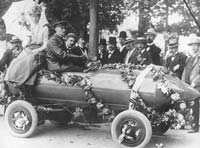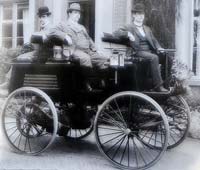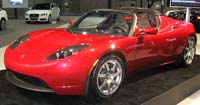












Electric Car History |
|||
| Classic and Hot Rod Cars And Their Stories | |||
| Brief History of the Electric Car | |||
Between 1832 and 1839 (the exact year is uncertain), Robert Anderson of Scotland invented the first crude electric carriage. A small-scale electric car was designed by Professor Stratingh of Groningen, Holland, and built by his assistant Christopher Becker in 1835. Practical and more successful electric road vehicles were invented by both American Thomas Davenport and Scotsmen Robert Davidson around 1842. Both inventors were the first to use non-rechargeable electric cells. Frenchmen Gaston Plante invented a better storage battery in 1865 and his fellow countrymen Camille Faure improved the storage battery in 1881. This improved-capacity storage battery paved the way for electric vehicles to flourish. France and Great Britain were the first nations to support the widespread development of electric vehicles in the late 1800s. In 1899, a Belgian built electric racing car called "La Jamais Contente" set a world record for land speed - 68 mph - designed by Camille Jénatzy.It was not until 1895 that Americans began to devote attention to electric vehicles after an electric tricycle was built by A. L. Ryker and William Morrison built a six-passenger wagon both in 1891. Many innovations followed and interest in motor vehicles increased greatly in the late 1890s and early 1900s. In 1897, the first commercial application was established as a fleet of New York City taxis built by the Electric Carriage and Wagon Company of Philadelphia. The early electric vehicles, such as the 1902 Wood's Phaeton were little more than electrified horseless carriages and surreys. The Phaeton had a range of 18 miles, a top speed of 14 mph and cost $2,000. Later in 1916, Woods invented a hybrid car that had both an internal combustion engine and an electric motor. By the turn of the century, America was prosperous and cars were now available in steam, electric, or gasoline versions, and becoming more popular. The years 1899 and 1900 were the high point of electric cars in America, as they outsold all other types of cars. Electric vehicles had many advantages over their competitors in the early 1900s. They did not have the vibration, smell, and noise associated with gasoline powered cars. Changing gears on gasoline cars was the most difficult part of driving, while electric vehicles did not require gear changes. While steam powered cars also had no gear shifting, they suffered from long start-up times of up to 45 minutes on cold mornings. The steam cars had less range before needing water than an electric's range on a single charge. The only good roads of the period were in town, causing most travel to be local commuting, a perfect situation for electric vehicles, since their range was limited. The electric vehicle was the preferred choice of many because it did not require the manual effort to start, as with the hand crank on gasoline vehicles, and there was no wrestling with a gear shifter. While basic electric cars cost under $1,000, most early electric vehicles were ornate, massive carriages designed for the upper class. They had fancy interiors, with expensive materials, and averaged $3,000 by 1910. Electric vehicles enjoyed success into the 1920s with production peaking in 1912. The decline of the electric vehicle was brought about by several major developments:
While electric cars produce little air pollution, generating electricity continues to be a major source of air pollution. If an electric car is recharged with electricity produced by a fossil fuel burning generator, there may be no net benefit at all to the atmosphere, something to think about before buying a new all electric vehicle hoping to save the planet. |
|||
Note: All Images And Stories On This Site Are Copywrited. Use Of Any |
|||
 Great Pricing & Selection of Cameras and Accessories: Top Camera Mall |
|||
|
|||



